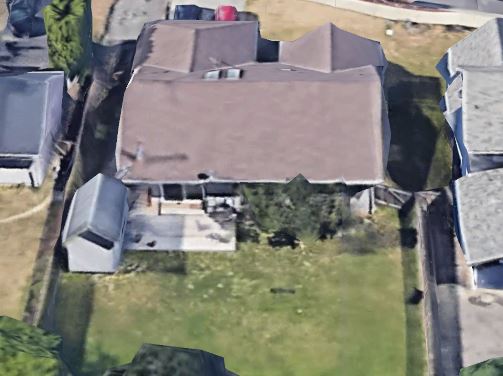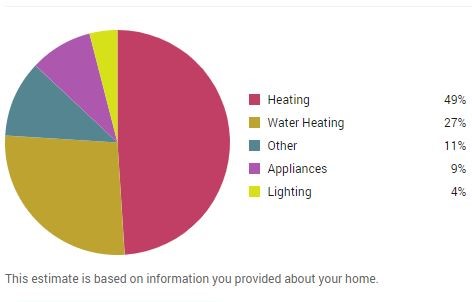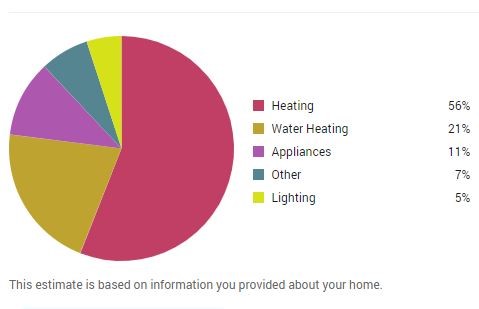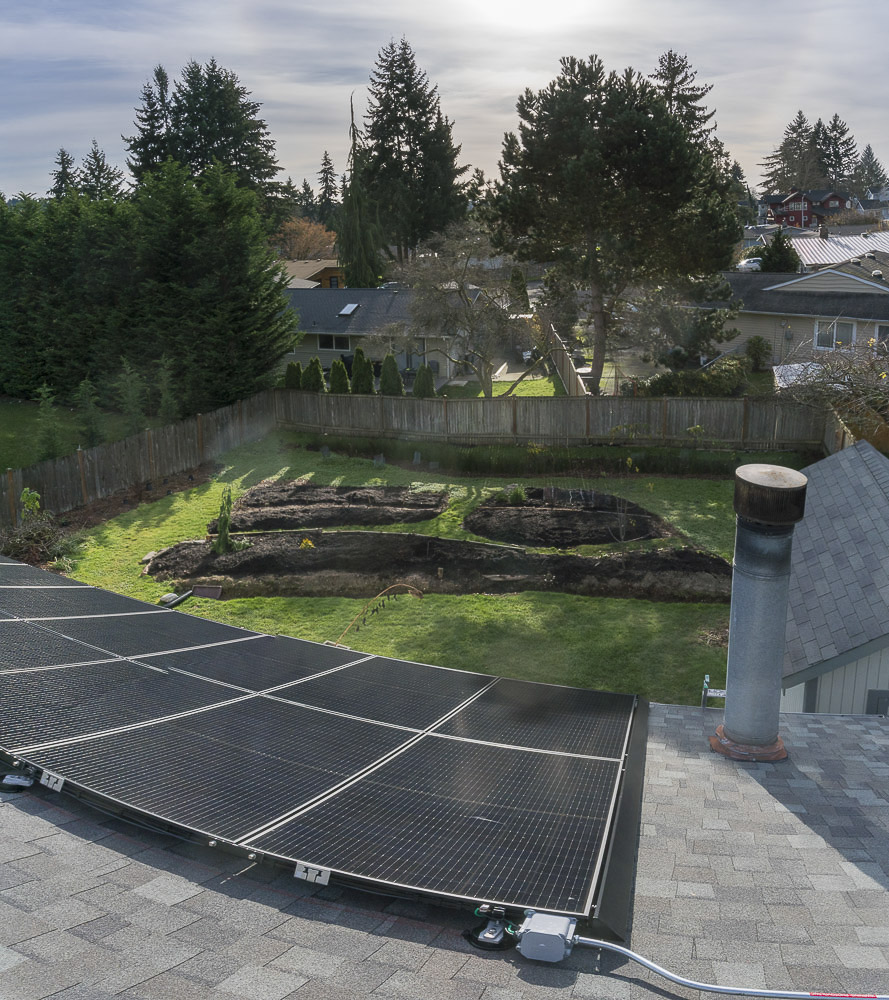
The cost of solar energy, now the cheapest electricity in much of the world, has dropped 76% since 2009. In the United States residential panel installed cost dropped from $8.50/watt to as low as $2.01/watt before incentives. In October, 2020, we paid $1.46/watt, after taking advantage of the 26% federal tax credit. That puts the levelized solar cost for Seattle─the northernmost and cloudiest metropolitan area in the country─at an amazing $.053/kwh.* Net metering in many states allows excess solar production to feed the grid, banking surplus summer gains against winter deficits (states differ on how this is implemented). Residential solar at good sites can cancel 100% of home energy as well**, even including enough juice to power thousands of miles of an electric car. Rooftop solar is a sincere, practical step we can take to reduce our carbon footprint.*** Our Kirkland home is a case study.
 Kate and I moved into a 1560-ft-sq, single-level Kirkland home in 2018. Built in 1987, it has 6-inch stud walls and excellent south-north ventilation. Passive solar gathers heat on (rare) sunny winter days through generous south-facing glass. A/C isn’t a necessity. The large, south-facing roof area, with minimal blockage from neighboring trees, is ideal for solar. Significantly, though, our home is all gas: gas furnace, gas stove, gas hot water, gas dryer. The stove and hot water heater are old and due for replacement.
Kate and I moved into a 1560-ft-sq, single-level Kirkland home in 2018. Built in 1987, it has 6-inch stud walls and excellent south-north ventilation. Passive solar gathers heat on (rare) sunny winter days through generous south-facing glass. A/C isn’t a necessity. The large, south-facing roof area, with minimal blockage from neighboring trees, is ideal for solar. Significantly, though, our home is all gas: gas furnace, gas stove, gas hot water, gas dryer. The stove and hot water heater are old and due for replacement.
Despite exceptional solar access, gas is cheap, and our bill for a year’s gas and electric use is under $900 after subtracting fixed monthly fees. Tiered Puget Sound Energy (PSE) electricity costs about $.09/kwh; $.11 if over 600/kwh/month. We do not have time-of-use metering. Gas is about $.90/therm. Strictly looking at payback, estimating savings should consider the cost against current usage, i.e. gas, not against electricity saved after converting gas appliances.


I built an energy use model for our home from one year of PSE bills. The hump from winter heating─the biggest use─was easy to extract. I used the PSE website model as a start for other uses. Their model erred a bit, under-estimated heat and over-estimated hot water. We’re home during the day (more heat) and we take short showers (less hot water), circumstances not addressed by the model’s generic questions. When I ran the PSE model assuming a 1-person household, it came close to our actual usage.

From billing data, space heating was 58%. I estimated hot water at 17%, gas stove 7% and dryer at 3%. For simplicity I put everything electrical into other, which came to 15% (refrigerator, lighting, computer, TV, dish washer, clothes washer).****
Onward to solar
On-line solar calculators estimate solar production of 1077 kwh/kw/year for a Kirkland, WA home with a south-oriented roof and 6/12 slope. From there, estimating the kw (rated kilowatts of solar) for each energy use falls out by division. For example, from billing, our one year electrical use totaled 2937 kwh. It follows that 2937kwh/yr/1077kwh/kw/yr = 2.73kw, so we need 2.73 kw of installed solar to match that use. Below is a table for all usage, after gas conversions. We will convert gas appliances to electric as they wear out, and add an electric car. For replacing the gas hot water heater, I listed the kw needed for a standard electric hot water heater and an alternative heat pump water heater. For the gas furnace, I converted the gas heat energy to electric (10.2 kw), and then estimated the reduced kw required for a heat pump (3.41 kw with a COP of 3).
| All current electrical | 2.73 kw |
| Hot water/heat pump water heater | 2.77 kw/1.2 kw |
| Gas furnace/ Heat Pump | 10.2kw/3.41 kw |
| Electric Car (10000 miles) | 2.73 kw |
| Stove | 1.15 kw |
| Gas dryer | .45 kw |
Total conversion assuming heat pump replaces gas furnace 13.24 kw
Total assuming heat pump and heat pump watr heatr 11.68 kw
Total without gas furnace/dryer conversions, but std. watr heatr 9.38 kw
Total without gas furnace/dryer converions, heat pump watr htr 7.81 kw
36 panel 340w/panel solar array 12.24 kw
24 panel 340w/panel solar array 8.16 kw
Good news
Our 46’x24’ south-facing roof can fit 36 solar panels, with room on one side for fire access and an 18” gap below the ridge line as code requires. The panels we ordered rated 340 watts; 36 panels equals 12.24 kw. Converting everything, we could generate enough electricity to fully meet all our needs, including an electric car (12.24 kw > 11.68 kw, or, if we assume a standard electric water heater 12.24 < 13.24 kw, we’d come up a bit short).
Cheap gas
But. While solar can be an economic choice for electricity, converting from gas appliances is another story. As an example, our gas hot water heater consumes about 115 therms/yr., or $104/yr at $.90/therm. For the same output, an electric hot water heater, assuming better efficiency compared to gas (.82/.65), would run $266/yr at $.10/kwh. A heat pump water heater could compete on energy cost, but the appliance cost is quite a bit more.
Decision and payback
The condition of the existing roof is always a factor when considering solar. Ours had a few years of use left, but we decided to replace it before the solar installation. A nice thing is we now have a better looking roof to enjoy; the downside is the old roof still had a value that I put at $4000. I did not add this cost to the payback analysis.

In the end, we decided to order 24 solar panels, or 8.16 kw. This is enough production to cover everything but the furnace and dryer. The gas hot water heater and gas stove will be electric soon. It makes no economic sense to replace our relative new gas furnace when heating our house, with gas costing $340/yr and a heat pump costing $10k or more. Generally, converting homes to all electric economically will depend greatly on efficient, reliable, reasonably-priced heat pumps. A boost from incentives or a price on carbon emissions would help. My crystal ball says in 10 years we’ll add that third row of twelve solar panels, and convert to a heat pump and electric clothes dryer, becoming an all-electric household.
Our 8.16 kw installation, after a 26% federal tax credit (2020), and state sales tax waved, cost under $12,000. Looking just at the electric rate of $.10/kwh, in the Seattle area that yields a simple payback of 13.6 years. Considering that we will be replacing gas appliances that are cheap to operate, savings are reduced, stretching the payback to about 18 years.
Note: I didn’t include petrol savings for the electric car. Assume 8000 miles/yr free charging, $3/gal and 36 mpg, fuel savings comes to $667/yr. In 20 years, that alone is over $13,000.
General good news
Solar panels are cheap, and getting cheaper. Roughly two-thirds of our cost is in the inverter, installation, mounting hardware and permits, only one-third in the panels themselves. In solar-rich West Texas─to use a favorable location─with solar generation at 1838 kwh/kw/yr and a utility rate of $.12/kwh, payback would be 6.8 years and levelized cost $.031/kwh. Little wonder recent solar cost is as low as $.0135/kwh for recent utility-scale installations in favorable climates.1 Our solar panels are 19% efficient, a bit better than the median for year 2020. Down the road, expect even better efficiency and more cost reductions.
Every State in the USA has enough renewable potential to meet all energy needs using a mix of solar, wind, batteries, pumped storage, load shifting and peak-load pricing. The transformation to renewables will create jobs, stimulate the economy and help secure the future of our grandchildren. Not to mention its importance to national security. I welcome the energy security implications of a solar future. Although this poses difficulties to petro states, developed and developing nations will benefit from a renewable future without a pernicious dependency on fossil fuels.
Bad News/Good news
The greenhouse gases that we pump into the atmosphere are perilously warming the planet, with no penalty for the fossil fuels that cause it. The failure to price carbon for planet destruction (negative externalities) is the greatest world-wide market failure in history. Fossil fuel subsidies continue, with China, the United States and Russia the worst offenders.2 America consumes 32 times more resources per capita compared to third world countries, and twice that of Europe, according to Jared Diamond.3 Although under President Biden, we’ll re-join the Paris accord, and he has a moderately ambitious climate plan, a rapid transition away from fossil fuel consumption has huge opposition. Under Trump, hard-fought-for environmental regulations have been gutted to serve polluting industries and short-run jobs. We’ve largely lost four years under a president who relishes sticking it to the climate. We’re fortunate that existing renewable energy tech can compete, and will outdo, dirty energy. A brighter future at lower cost and arguably greater freedom is on its way.
*Levelized Cost of Energy
I assume here a zero discount rate, or, the discount rate matches inflation, so they zero each other out. It also assumes south-facing panels at a 26° tilt in Seattle. The calculation then becomes cost (~$12000), divided by energy generated (1077kwh/kw/yr*30yrs*8.16kw/(1+.005)30 = 277,010 kwh. $12000/277,010kwh = $.053/kwh
**One could also make a carbon neutral claim, but the electric utility isn’t green, and we’re still using dirty electricity, especially in winter. Electrical generation from PSE in Washington State has a ways to go before the grid is 100% renewable. Although PSE is divesting from coal soon, only about one-third of their energy is renewable (mostly hydro), with 1% wind and negligible solar. One roadblock: PSE is owned since 2009 by a foreign private-equity firm. They get a guaranteed 10% return facilitated by our public utility commission, and offshore it goes. I have to ask: How does it make sense that a foreign entity controls something as important as our energy? They are investing in gas plants to replace coal, rather short-sighted considering a State-mandated phase-out for fossil fuels. These investments get rolled into the rate-base, and we pay. We’ll end up footing the bill for stranded assets when the requirements of a clean grid aren’t met.
***Although most NW homes aren’t practical for rooftop solar, households and/or neighborhoods could pursue community solar, a sharing model which can reduce solar-entry cost but still provide the benefits: https://www.solarwa.org/community_solar
****Electricity is expensive compared to gas on a crude BTU basis. In our case, our electric usage was 15% of the energy going into our house, but the cost was 39%. Gas, 85% of energy, cost 61%. Of course, electricity is higher quality energy, used to power our lights, computers, refrigerators, etc. as well as heating and air conditioning. Practically, gas can only heat.